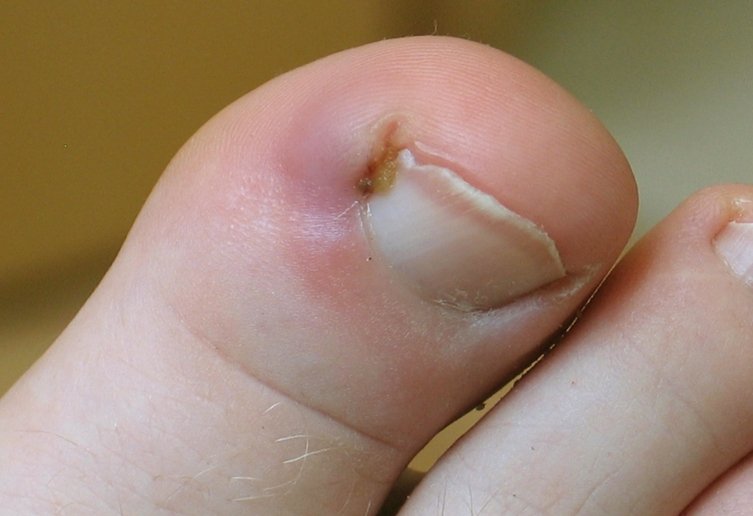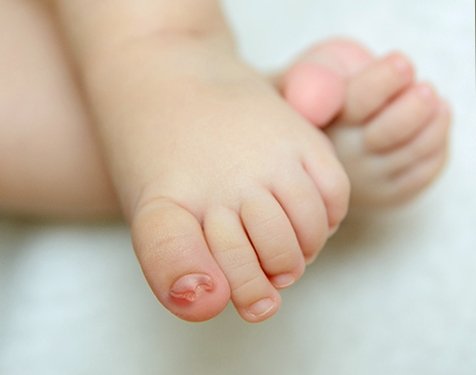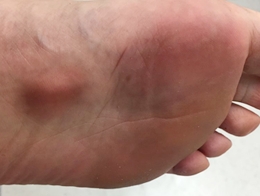Ingrown Toenails

Ingrown toenails are medically termed as onychocryptosis or unguis incarnatus. This is a common condition of the toenails that affects many people in different age groups. However, the people most commonly affected are people with diabetes, people in adolescence as well as young adults.
Symptoms of Ingrown Toenails
Ingrown nails are most common in the toes, although they may also be present in hands. In the toes, the most commonly affected toe is the big toe, also called the hallux. The most common symptom is pain, and occurs early when the problem arises. If ignored, the problem may progress to several other symptoms such as swelling, difficulty in walking, discharge and bleeding. There may also be redness and infection. For purposes of staging, the symptoms of ingrown nails are used to classify ingrown nails into four stages.
- The first stage is known as the inflammatory stage. This stage is characterized by pain, mostly when the outer part of the nail is pressed firmly, slight swelling and redness.
- The second stage is also known as the abscess stage. It is characterized by an increase in the symptoms observed in stage one. There is increased swelling, pain, redness, discharge and infection.
- The third stage is known as the hypertrophic stage. It is characterized by formation of granulation tissue (tissue that forms when wounds are healing) and increased growth of the nail fold-which is called hypertrophy. The fourth stage is known as the distal hypertrophic stage, whose main feature is a deformity of the toenail.
Other symptoms experienced may be as a result of complications of ingrown toenails. These complications include infections, which are quite common. Common infections due to ingrown toenails include bacterial infections and those infections caused by a fungus. Nails infected by fungus often take on a deep yellow hue. An affected person may notice a yellow nail. Another indicator of infection in an ingrown toenail is a blister which forms quite soon after an infection sets in. This may, in fact, be the first sign of an infection. Other complications include osteomyelitis and cellulitis which are extremely rare. On rare instances, there may be scarring.
Causes of Infected Ingrown Toenails
It has been noted that ingrown toenails are relatively common among people of certain demographic groups. Diabetics, for example, are more susceptible to ingrown toenails. It has also been noted that people with pre-existing nail abnormalities such as abnormally thick or abnormally thin nails, a big toe rotated towards the other toes, and a nail plate that has an abnormal shape are at greater risk of developing ingrown toenails.
There are several factors that contribute to development of ingrown toenails. These include:
Birth abnormalities
 Ingrown toenails that are present at birth are termed congenital. These are thought to be as a result of either genetic influence – where a parent who has ingrown toenails is thought to pass genes that make the baby susceptible to ingrown toenails. It may also be due to trauma incurred during pregnancy.
Ingrown toenails that are present at birth are termed congenital. These are thought to be as a result of either genetic influence – where a parent who has ingrown toenails is thought to pass genes that make the baby susceptible to ingrown toenails. It may also be due to trauma incurred during pregnancy.
Improper nail care
The most common cause of ingrown nails as concerns nail care is often wrong trimming of the nails. Where most people trim their nails in a round fashion, trimming should be preferably done in a straight line. The nail should not be trimmed too short so as to ensure the nail fold does not grow over the nail. It is also paramount that the nail clipper that one uses is clean and hygienic.
Poor foot care
When foot hygiene is improper, there is increased susceptibility to infection. Although infection is usually a result of ingrown toenails, it may actually be the cause. When toenails become infected, they become weak and brittle, resulting in them breaking easily. These broken parts of the nails may get lodged in the nail fold, thereby resulting in ingrown toenails.
Increased pressure on the foot
This is usually a result of poorly-fitting shoes. Tight shoes press upon the toes and cause the nail fold to press into the toe nail.
Increased sweating of the foot
This can also be brought about by poorly fitting shoes. Walking or conducting any activity in them is not only very uncomfortable but results in profuse sweating. This can also be the cause in adolescents who often sweat a lot. In both of these situations, sweat makes the nail fold softer than usual, making it possible for the nail to lodge in the nail fold easily. (Related: Sweaty feet causes and treatment)
There are other factors that may contribute to development of ingrown toenails. Some antiretroviral drugs, like Indinavir have been demonstrated to result in higher incidences of ingrown toenails among those who use these drugs. Tumors and other forms of growths affecting the nail bed, for example warts, and previous nail surgery may also result in ingrown nails.
Home Remedies
Home remedies are usually beneficial for stage one and some stage two ingrown nails. However, it is always advisable to take caution when applying these home remedies. For example, it is not advisable to try and remove the part of the nail that has grown into the nail fold using nail clippers or other apparatus available in homes and used for cutting. A diabetic who develops ingrown toenails must at all times seek medical advice. They should not try any home remedies as these may prove to be more detrimental to their health. This caveat also applies to people with any vascular or circulatory anomalies.
Home remedies for ingrown toenails include:
- Use of appropriate shoes and footwear: This may also be protective for those who have not yet developed ingrown toenails but are at risk of developing them. Shoes should be well fitting, not too big and not too small. Those who have developed ingrown toenails may opt for sandals to reduce pressure on the big toe. It may also offer relief from pain.
- Proper nail care: As explained earlier, nails should be clipped in a straight line, not in a rounded fashion. A clean nail clipper should also be used.
- Dental floss and cotton placed under the toenail: These may be placed directly under the nail after cleaning the feet. The elevation of the toenail will remove the edge of the toenail from direct contact with the nail fold. This may prevent further in-growth of the nail and may also offer reprieve from any pressure exerted upon the nail.
- Pain medications: These help to relieve the pain, thus decreasing the discomfort associated with walking, sporting and schooling activities.
- Foot care and relief: Foot care regimen involves cleaning the foot properly every day. One may also soak their feet in warm soapy water or water mixed with Epsom salts. There are also available soaks that are antibacterial and anti-inflammatory that may be helpful. Essential oils, including coconut, rosemary or clove oil may be applied to the region of the nail to enable it to grow normally.
- Antibiotic cream: One can apply antibiotic cream to the area with pain. This would help prevent infection or get rid of any existing infection. One may also apply silver nitrate, hydrogen peroxide and iodine to the affected area to clean it and possibly disinfect it.
How to Treat Ingrown Toenails?
Treatment for ingrown toenails is recommended for diabetics, those with vascular or circulatory problems, those with stage two and above ingrown nails and those for whom home remedies do not work. Delayed treatment may result in gangrene (death of the affected tissue). Treatment options include:
Controlling the underlying conditions
As stated earlier there are several causes of ingrown nails. Some of these can be controlled or at least prevented. This can be done by:
- Use of oral and topical antibiotics: These would be essential in treating and preventing any bacterial and fungal infections, and would require a prescription from a doctor.
- Managing blood sugar levels to reduce the risk of a patient with diabetes developing ingrown nails.
- Proper maternal care during pregnancy: This would reduce the number of babies born with congenital ingrown nails following the effect of trauma.
Using splints
These vary in design, make and material. They are placed under the ingrown nail-at the edge of the nail- to elevate the nail permanently allowing the wound to heal and enabling the edge of the nail to be excised.
Cutting
Cutting any skin or tissue that has grown around the nail. This is usually a surgical procedure. It would require that the tissue into which the edge of the nail has grown is made numb, by use of local anesthetic, and then cut. This can be done by resection of a wedge-shaped portion of the nail fold and the ingrown part of the nail.
Partial or total matricectomy
This refers to surgical or chemical destruction of part of or the entire matrix of the nail. Destruction of the nail matrix would prevent additional nail tissue growth. This is done in recurrent ingrown toenails, along with excision of any fragments that may have broken off from the nail.
Laser treatment
This uses a carbon dioxide laser to remove warts present around the region of the nail as these cause ingrowth of nails. Laser treatment also requires use of an anesthetic to numb the region.
Cryotherapy
Cryotherapy is quite literally, treatment that uses cold. It is used to freeze the affected part of the nail, causing the tissue to be destroyed.





